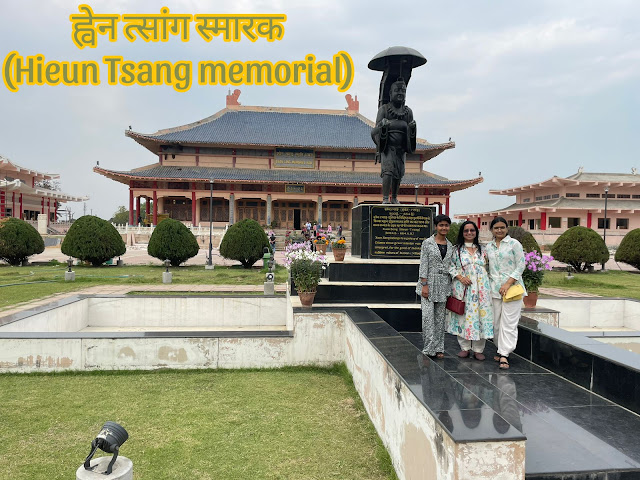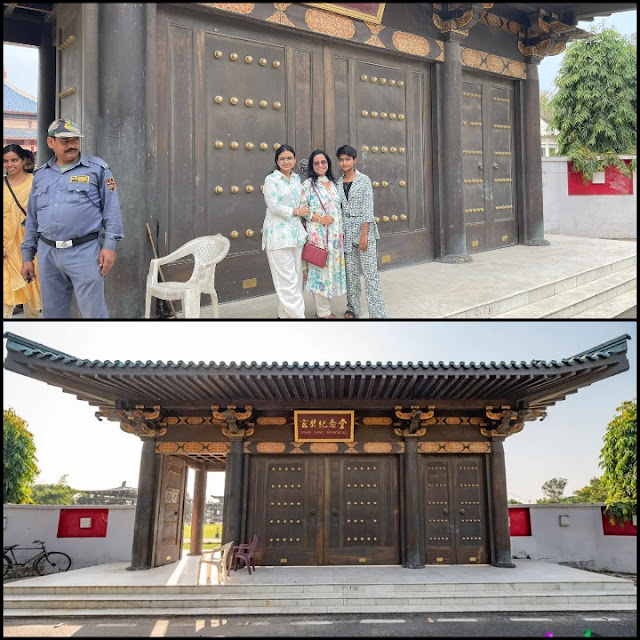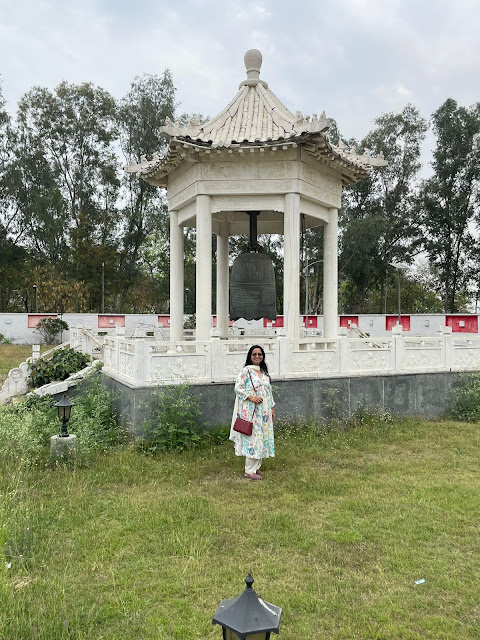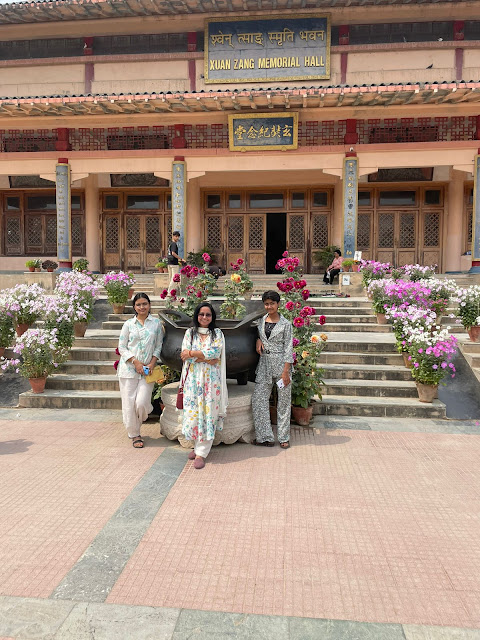ह्वेन त्सांग स्मारक (Hieun Tsang memorial)
जैसा कि हम सभी जानते हैं भारतीय संस्कृति भारत के विस्तृत इतिहास, साहित्य, विलक्षण भूगोल, विभिन्न धर्मों तथा उनकी परम्पराओं का सम्मिश्रण है। भारत एक ऐसा देश है, जहां धार्मिक विविधता और सहिष्णुता को कानून और समाज दोनों की मान्यता प्राप्त है। खैर, चलिए आज हम बात करेंगे बिहार के नालंदा जिले में स्थित ह्वेन त्सांग स्मारक की जिसका निर्माण चीनी विद्वान भिक्षु और यात्री हेनसांग के सम्मान में किया गया था। ह्वेन त्सांग नालंदा विश्वविद्यालय के एक छात्र थे, बाद में वे नालंदा विश्वविद्यालय में शिक्षक भी बन गए।
ह्वेन त्सांग एक लोकप्रिय चीनी यात्री थे, जो 633 ईस्वी में नालंदा विश्वविद्यालय में बौद्ध धर्म और रहस्यवाद का अध्ययन करने के लिए भारत आये और वह 12 वर्षों तक यहां रहे। त्सांग ने देश भर की यात्रा की और बौद्ध धर्म पर गहन अध्ययन के लिए तक्षशिला का भी दौरा किया।
सूरजपुर झील के किनारे प्राचीन नालंदा विश्वविद्यालय के खंडहरों के पास (लगभग एक से डेढ़ किलोमीटर की दूरी पर) जिस स्थान पर वे अपने शिक्षक आचार्य शील भद्र से योग सीखते थे, वहीं पर इस स्मारक को बनाया गया है, जो वर्तमान में बिहार के सबसे प्रसिद्ध दर्शनीय स्थलों में से एक है। ह्वेन त्सांग मेमोरियल हॉल नालंदा विश्वविद्यालय की स्थापत्य शैली का एक विशिष्ट अनुस्मारक है। पूरे भवन परिसर को पारंपरिक चीनी मंदिर के रूप में डिजाइन किया गया है।
निर्माण में लग गए 24 साल
इस ह्वेन सांग मेमोरियल हॉल का निर्माण कार्य 1960 में शुरू किया गया था, जिसे बनाने में 24 साल लगे और यह 1984 में बनकर तैयार हुआ। इस मेमोरियल हॉल का निर्माण भारत चीन के सांस्कृतिक संबंधों को बढ़ाने के उद्देश्य से किया गया था। इस हॉल का निमार्ण का फैसला 1957 में किया गया था। अपने प्रवास के दौरान, त्सांग ने कई दस्तावेज एकत्र किए जो बौद्ध लेखन के इतिहास का एक प्रमुख स्रोत है। ये सभी मेमोरियल हॉल में अच्छी तरह से संरक्षित हैं।
प्राचीन नालंदा की शैली पर ही है बना
यह स्मारक कक्ष प्राचीन नालंदा विश्वविद्यालय की शैली के आधार पर ही बनाया गया है। इस जगह पर ह्वेन त्सांग के जीवन के बारे में बहुत कुछ जानने को है। स्मारक के अंदर प्रदर्शित कुछ चित्रों में भगवान बुद्ध की चंदन और सुनहरी मूर्तियों के साथ ह्वेन त्सांग की रचनाएं और भारत और चीन में बौद्ध धर्म के बारे में काफ़ी सारी अध्ययन की किताबें और रचनाएं रखी हुई हैं। बेहद सुकून और शांति वाली जगह है। कभी बिहार घूमने का मन हुआ तो यहाँ भी जरूर जाइए।
20 वर्ष की अवस्था में बौद्ध भिक्षु बने ह्वेन सांग
ह्वेनसांग का जन्म 630 ईसा के लगभग एक सामान्य परिवार में हुआ था। 3 भाइयों में सबसे छोटे थे और उनका स्वभाव अपने दोनों भाइयों से कुछ अलग ही था। युवा अवस्था में आते ही बौद्ध धर्म का आकर्षण उनमें ऐसा जागा कि उन्होंने बौद्ध भिक्षु बनने का संकल्प लिया। 20 वर्ष की अवस्था में बौद्ध भिक्षु बनने के बाद उन्होंने चीनी बौद्धविहारों में इस धर्म-दर्शन को गंभीरता से जानना चाहा, लेकिन उनकी ज्ञानपिपासा वहां शान्त न हो सकी। उसके बाद उन्होंने निश्चय किया कि वह भारत जाकर वहां के मूल का अध्ययन करेंगे। वह मध्य एशिया के रास्ते ताशकन्द, समरकन्द तथा काबुल होते हुए 1 वर्ष की यात्रा कर भारत पहुंचे।
सम्पूर्ण भारत का भ्रमण करते हुए वे मगध की राजधानी पाटलीपुत्र पहुंचे, जो उस समय ज्ञान, शिक्षा व संस्कृति का केन्द्र थी। यहां पर उनकी ज्ञान पिपासा शान्त हुई। उन्होंने यहाँ के मन्दिरों, स्तूपों, उघैर विहारों का दर्शन किया। बोधगया जाकर महात्मा बुद्ध के दर्शन की अनुभूति उन्हें प्राप्त हुई, जिसके बाद वह ज्ञान के सबसे बडे केन्द्र नालंदा विश्वविद्यालय पहुंचे।
निर्माण का प्रस्ताव "जगदीश कश्यप" द्वारा रखा गया था
ह्वेन त्सांग द्वारा किए गए कार्यों की स्मृति में इस स्मारक हॉल के निर्माण का प्रस्ताव "जगदीश कश्यप" द्वारा रखा गया था। वह एक बौद्ध विद्वान थे और 1950 के दशक में वह नव नालंदा महाविहार के निदेशक थे। वह ह्वेन त्सांग के नाम पर एक स्मारक हॉल का निर्माण करके उन्हें सम्मानित करने के लिए एक स्मारक बनाना चाहते थे। इसके लिए उन्होंने झोउ एनलाई, जो उस समय पीपुल्स रिपब्लिक ऑफ चाइना के प्रधान मंत्री थे, से ह्वेन त्सांग से संबंधित अवशेषों को मेमोरियल हॉल में रखने के लिए भेजने का आग्रह भी किया था।
कौन थे "जगदीश कश्यप"
शुरुवात में "जगदीश कश्यप" आर्य समाज में थे और एक प्रचारक के पद तक पहुंचे, बाद में श्रीलंका में जीवन के दौरान उनका परिचय बौद्ध धर्म से हुआ, जिसे उन्होंने अपनी भावी जीवन शैली के रूप में अपनाया। वह भारत वापस आये और स्वतंत्रता के बाद 1951 में वह पाली संस्थान के निदेशक बने जिसे अब हम नव नालंदा महाविहार के नाम से जानते हैं। उन्होंने इस संस्थान को शुरू करने और विकसित करने में महत्वपूर्ण भूमिका निभाई, जो अब एक डीम्ड विश्वविद्यालय है। अपने जीवनकाल में उन्होंने लगभग इकतालीस खंडों में कई त्रिपिटक ग्रंथों का अनुवाद किया।
English Translate
Hieun Tsang Memorial
As we all know, Indian culture is a combination of India's extensive history, literature, unique geography, various religions and their traditions. India is a country where religious diversity and tolerance are recognized by both law and society. Well, today we will talk about the Hiuen Tsang Memorial located in Nalanda district of Bihar, which was built in honor of the Chinese scholar, monk and traveler Hien Tsang. Hiuen Tsang was a student of Nalanda University, later he also became a teacher at Nalanda University.
Hiuen Tsang was a popular Chinese traveller, who came to India in 633 AD to study Buddhism and mysticism at Nalanda University and stayed here for 12 years. Tsang traveled across the country and also visited Takshashila for in-depth study on Buddhism.
This memorial has been built near the ruins of the ancient Nalanda University on the banks of Surajpur Lake (at a distance of about one to one and a half kilometres), at the place where he used to learn yoga from his teacher Acharya Sheel Bhadra, which is currently one of the most famous in Bihar. One of the famous tourist places. The Hiuen Tsang Memorial Hall is a distinctive reminder of the architectural style of Nalanda University. The entire building complex is designed as a traditional Chinese temple.
It took 24 years to build
The construction work of this Hiuen Tsang Memorial Hall was started in 1960, which took 24 years to build and it was completed in 1984. This memorial hall was built with the aim of enhancing cultural relations between India and China. The decision to construct this hall was taken in 1957. During his stay, Tsang collected many documents which form a major source for the history of Buddhist writing. All of these are well preserved in the Memorial Hall.
It is built on the same style as ancient Nalanda.
This memorial hall has been built on the basis of the style of the ancient Nalanda University. There is a lot to know about the life of Hiuen Tsang at this place. Some of the paintings displayed inside the memorial include sandalwood and golden statues of Lord Buddha along with the works of Hiuen Tsang and a number of study books and works about Buddhism in India and China. It is a very peaceful and peaceful place. If you ever feel like visiting Bihar, then definitely visit here.
Hiuen Tsang became a Buddhist monk at the age of 20.
Hiuen Tsang was born in an ordinary family around 630 AD. He was the youngest among 3 brothers and his nature was somewhat different from that of his two brothers. As soon as he reached his young age, he became so attracted to Buddhism that he resolved to become a Buddhist monk. After becoming a Buddhist monk at the age of 20, he wanted to seriously learn about this religious philosophy in Chinese Buddhist monasteries, but his thirst for knowledge could not be quenched there. After that he decided that he would go to India and study its origins. He reached India after traveling for one year through Central Asia via Tashkent, Samarkand and Kabul.
While touring the whole of India, he reached Pataliputra, the capital of Magadha, which was the center of knowledge, education and culture at that time. Here his thirst for knowledge was quenched. He visited the temples, stupas and monasteries here. He went to Bodh Gaya and experienced the darshan of Mahatma Buddha, after which he reached Nalanda University, the biggest center of knowledge.
The proposal for construction was put forward by "Jagadish Kashyap"
The construction of this memorial hall to commemorate the works done by Hiuen Tsang was proposed by "Jagadish Kashyap". He was a Buddhist scholar and in the 1950s he was the director of Nava Nalanda Mahavihara. He wanted to create a memorial to honor Xuanzang by building a memorial hall in his name. For this, he also requested Zhou Enlai, who was the Prime Minister of the People's Republic of China at that time, to send the remains belonging to Xuanzang to be placed in the Memorial Hall.
1957 The Dalai Lama gifts a relic belonging to Xuanzang along with some Buddhist spiritual texts on behalf of the Chinese government. Originally the relic was kept in the Temple of Great Compassion in Tianjin. Along with this, a set of valuable books containing forty-one volumes of Tripitaka and an amount of approximately Rs. four lakhs were also sent as a gift for this initiative. These were received by the then Prime Minister of India, Jawaharlal Nehru in the year 1957. The Government of India provided additional funds of Rs 5 lakh for this initiative. Construction work began in 1960 and was completed in 1984, taking approximately twenty-seven years. There was an India-China war in the early 1960s and this may be the reason why the construction of the memorial hall took so many years. Since public sentiment was not in favor of the attacker, it was probably shelved.
Who was "Jagdish Kashyap"
Initially "Jagadish Kashyap" was in the Arya Samaj and rose to the position of a preacher, later during his life in Sri Lanka he was introduced to Buddhism, which he adopted as his future lifestyle. He returned to India and after independence in 1951 he became the director of the Pali Institute which we now know as Nava Nalanda Mahavihara. He played an important role in starting and developing this institution, which is now a deemed university. During his lifetime he translated several Tripitaka texts in about forty-one volumes.












Incredible Bharat 🇮🇳
ReplyDeleteVery interesting post 👍🏻👌
😍❤️Wah ji
ReplyDeleteVery interesting posts 👌👌👌👌
ReplyDeleteWow picture 😘😘😘😘
ReplyDeleteVery informative post 👍
ReplyDeleteWaah waah.....kya baat hai
ReplyDeleteVery nice
ReplyDeleteBahut barn
ReplyDeleteVery Nice 👍👌🏻
ReplyDeleteVery nice
ReplyDeleteA beautiful trip and beautiful memories.
ReplyDeleteinformative post
ReplyDelete🙏🙏💐💐शुभरात्रि 🕉️
ReplyDelete🚩🚩जय जय सियाराम 🚩🚩
👌👌👌बहुत बढ़िया जानकारी शेयर करने के लिए आपका बहुत बहुत धन्यवाद 💐💐